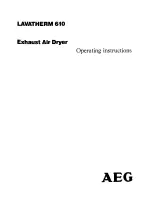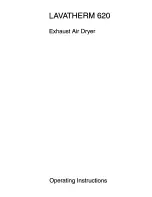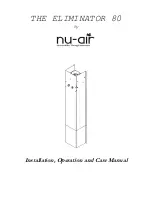
16
A) Water downstream of dryer
B) High pressure drop across dryer
C) Checkpoint faults
1. Power on light off
2. Compressor on light off
3. Alarm/Service alert light on - check
Display for active conditions
SERVICE DRYER
LOW PRESSURE
HIGH PRESSURE
NOTE: If high refrigerant pressure
occurs, switch must be manually reset
HIGH TEMPERATURE
(also observed as high reading on
temperature indicator)
DRAIN
COMPRESSOR
HEATER
TEMP SENSOR
TROUBLESHOOTING GUIDE
1. Residual free moisture remaining in
downstream pipelines
2. Air bypass system is open
3. Inlet and Outlet connections are reversed
4. Air lines downstream of dryer are exposed to
temperatures below the dew point.
5. Excessive free moisture (bulk liquid) at dryer
inlet
6. Condensate not being drained
7. Dryer overloaded resulting in elevated dew
point.
8. Refrigeration system not functioning
1. Excessive air flow
2. Freezing of moisture in evaporator because
of refrigeration system fault
3. Filter loaded with solid particulates
a. Power failure; open circuit
a. Compressor commanded off by manual
switch or programmed schedule
b. Open circuit
c. Control circuit open on high or low pressure
cutout
Service interval specified has elapsed
a. Hot gas bypass valve requires adjustment
b. Low on refrigerant
a. Lack of condenser cooling
Air-cooled - Ambient temperature too high,
clogged condenser fins, obstructed flow
across condenser, faulty fan motor or fan
control switch.
Water-cooled - Cooling temperature too
high, flow too low, clogged strainer, faulty
water regulating valve
a. Dryer overloaded
b. Refrigeration system off or not cooling
sufficiently
a. Drain line restricted or frozen
b. Drain mechanism faulty
a. Faulty compressor contactor.
b. Faulty N.O. auxiliary contact on compressor
contactor.
a. Faulty compressor contactor.
b. Faulty N.C. auxiliary contact on compressor
contactor.
a. Temperature sensor or wiring to sensor is
open (only the left-most LED in the tempera-
ture display will be illuminated).
b. Temperature sensor or wiring to sensor is
shorted (all of the LEDs in the temperature
display will be illuminated).
1. Blow out system with dry air
2. Check valve positions
3. Check for correct connection
4. Insulate or heat trace air lines exposed to
low ambients or dry air to lower dew point
5. Install separator ahead of dryer
6. See C below
7. See C below
8. See C below
1. Check flow rate
2. See C below
3. Replace filter element
a. Check for power to dryer
a. Check current command status
b. Check power to compressor
c. Check display for fault
Perform scheduled service
a. Contact qualified technician or
manufacturer’s service department
Check air temperature 6” in front of
condenser; Clean condenser and check
for free air flow;
Check fan and
switch operation
Check cooling medium temperature and
flow, clean strainer, check valve operation
a. Check compressed air flow, temperature,
and pressure
b. Check power to unit, power to compres-
sor, Low or High pressure faults. Have
qualified technician evaluate system
a. Open drain line
b Turn 3-way valve handle so it points out
from the front of the unit. Open and
adjust the manual petcock in rear leg for
manual draining. Rebuild drain mecha-
nism.
a. Check wiring and operation of contactor.
b. Check wiring and operation of auxiliary
contact.
a. Check wiring and operation of contactor.
b. Check wiring and operation of auxiliary
contact.
a. Replace sensor or repair wiring.
b. Replace sensor or repair wiring.
SYMPTOM
POSSIBLE CAUSE(S)
CORRECTIVE ACTION
NOTE: After fault correction, press reset button to clear display
Summary of Contents for HPRP 1000
Page 19: ...19 NOTES...





































